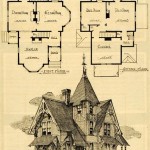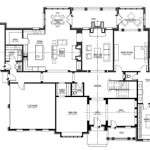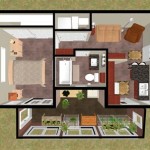Ultra-modern house floor plans represent a cutting-edge approach to residential design. They prioritize clean lines, open spaces, and an abundance of natural light to create homes that are both aesthetically pleasing and functional. One notable example of an ultra-modern floor plan is the “Infinity House,” which features a seamless integration of indoor and outdoor living areas, with expansive floor-to-ceiling windows that blur the boundaries between the two.
Ultra-modern floor plans often incorporate unique architectural elements such as floating staircases, cantilevered balconies, and rooftop terraces. These features not only add visual interest but also enhance the overall livability and flow of the home. Advanced materials and technologies are also employed in these plans to increase energy efficiency, reduce maintenance, and enhance comfort.
In the following sections, we will explore the key characteristics, benefits, and considerations associated with ultra-modern house floor plans, providing valuable insights for homeowners and architects alike.
Ultra-modern house floor plans are characterized by their emphasis on clean lines, open spaces, and an abundance of natural light. Here are ten important points to consider:
- Open floor plans
- Floor-to-ceiling windows
- Abundant natural light
- Neutral color palettes
- Minimalist design
- Sustainable materials
- Smart home technology
- Unique architectural elements
- Energy efficiency
- Enhanced livability
These elements combine to create homes that are both aesthetically pleasing and functional, offering a comfortable and contemporary living experience.
Open floor plans
Open floor plans are a defining characteristic of ultra-modern house floor plans. They involve the elimination of traditional walls and partitions between different living areas, such as the living room, dining room, and kitchen, creating a more spacious and fluid living environment.
- Enhanced flow and circulation: Open floor plans allow for seamless movement throughout the home, making it easier to navigate and interact with others.
- Abundant natural light: By removing walls, open floor plans allow for more natural light to penetrate the home, creating a brighter and more inviting atmosphere.
- Improved communication and interaction: Open floor plans facilitate better communication and interaction among family members and guests, as they can easily see and hear each other from different areas of the home.
- Versatile and adaptable: Open floor plans offer greater flexibility and adaptability, as furniture and other elements can be easily rearranged to suit changing needs and preferences.
Overall, open floor plans in ultra-modern houses contribute to a more spacious, light-filled, and adaptable living environment that promotes communication and interaction.
Floor-to-ceiling windows
Floor-to-ceiling windows are a prominent feature in ultra-modern house floor plans, offering a number of advantages:
- Abundant natural light: Floor-to-ceiling windows allow for maximum natural light to enter the home, creating a brighter and more inviting atmosphere. This natural light can help to reduce the need for artificial lighting, saving energy and creating a more natural and healthy living environment.
- Enhanced views: Floor-to-ceiling windows provide unobstructed views of the surrounding landscape, whether it’s a serene garden, a bustling city skyline, or a picturesque mountain range. These expansive views can create a sense of connection with the outdoors and bring the beauty of nature into the home.
- Spaciousness and openness: Floor-to-ceiling windows visually expand the space of a room, making it feel more spacious and open. They eliminate the visual barriers created by traditional windows, allowing for a more seamless connection between the interior and exterior.
- Architectural interest: Floor-to-ceiling windows add a striking architectural element to a home’s faade. They create a modern and sophisticated aesthetic that sets the home apart from more traditional designs.
Overall, floor-to-ceiling windows in ultra-modern house floor plans contribute to a brighter, more spacious, and visually appealing living environment that connects the indoors with the outdoors.
Abundant natural light
Abundant natural light is a hallmark of ultra-modern house floor plans. It contributes to a brighter, more inviting, and healthier living environment. Here are some key benefits of natural light in these homes:
- Improved mood and well-being: Natural light has been shown to have a positive impact on mood and well-being. It can boost energy levels, reduce stress, and improve sleep quality.
- Enhanced cognitive function: Natural light can improve cognitive function, including memory, attention, and problem-solving abilities.
- Reduced need for artificial lighting: Abundant natural light reduces the need for artificial lighting during the day, leading to energy savings and a more natural and healthy living environment.
- Improved indoor air quality: Natural light helps to improve indoor air quality by reducing moisture levels, which can inhibit the growth of mold and mildew.
Ultra-modern house floor plans are designed to maximize natural light through the use of floor-to-ceiling windows, skylights, and other architectural features. These homes offer a bright and airy atmosphere that promotes a healthier and more enjoyable living experience.
Neutral color palettes
Neutral color palettes play a significant role in ultra-modern house floor plans, contributing to their clean, minimalist, and sophisticated aesthetic. These palettes typically consist of shades of white, black, gray, and beige, which provide a backdrop that allows other elements of the home, such as furniture, artwork, and architectural features, to take center stage.
The use of neutral colors in ultra-modern house floor plans offers several advantages:
- Versatility and adaptability: Neutral colors are incredibly versatile and can be paired with a wide range of other colors and styles. This allows homeowners to easily change the look and feel of their home by simply updating their furniture, artwork, and accessories.
- Timeless appeal: Neutral colors have a timeless appeal that transcends changing trends. They create a classic and elegant foundation that will remain stylish for years to come.
- Enhanced spaciousness: Light neutral colors, such as white and beige, can make a room feel more spacious and airy. This is especially beneficial in smaller homes or rooms with limited natural light.
- Improved natural light reflection: Neutral colors reflect natural light more effectively than darker colors, contributing to a brighter and more inviting atmosphere.
When selecting neutral colors for an ultra-modern house floor plan, it’s important to consider the overall style and mood desired. Cool neutrals, such as gray and beige, create a more contemporary and sophisticated look, while warm neutrals, such as cream and light brown, exude a warmer and more inviting ambiance.
By carefully selecting and incorporating neutral color palettes, ultra-modern house floor plans achieve a clean, minimalist, and timeless aesthetic that enhances the overall living experience.
Minimalist design
Minimalist design is a fundamental aspect of ultra-modern house floor plans, emphasizing simplicity, clean lines, and a focus on essential elements. This design approach aims to create a sense of spaciousness, tranquility, and order within the home.
Here are some key characteristics of minimalist design in ultra-modern house floor plans:
- Clean lines and simple forms: Minimalist design favors clean lines, geometric shapes, and uncluttered spaces. This creates a sense of order and visual harmony, allowing the architectural features and natural light to take center stage.
- Neutral color palettes: Neutral color palettes, such as white, black, gray, and beige, are commonly used in minimalist design to create a calming and understated backdrop. These colors allow other elements, such as furniture and artwork, to stand out without creating visual clutter.
- Emphasis on natural materials: Natural materials, such as wood, stone, and concrete, are often incorporated into minimalist designs to add warmth and texture to the space. These materials bring a sense of the outdoors in and create a connection to nature.
- Open and fluid spaces: Open floor plans and fluid spaces are characteristic of minimalist design, allowing for seamless movement and interaction throughout the home. This creates a sense of spaciousness and encourages a more communal living experience.
Overall, minimalist design in ultra-modern house floor plans fosters a sense of simplicity, tranquility, and order, creating a harmonious and inviting living environment.
Sustainable materials
Sustainable materials play a crucial role in ultra-modern house floor plans, contributing to the environmental consciousness and overall well-being of the occupants. These materials are ethically sourced, renewable, and designed to minimize the home’s environmental footprint.
One of the key advantages of sustainable materials is their durability and longevity. They are designed to withstand the elements and last for many years, reducing the need for frequent replacements and renovations. This not only saves resources but also reduces the long-term costs associated with home maintenance and repairs.
In addition to their durability, sustainable materials often offer superior thermal insulation and energy efficiency. They can help regulate the temperature inside the home, reducing the need for heating and cooling systems and lowering energy consumption. This contributes to a more comfortable living environment while also reducing the home’s carbon footprint.
Furthermore, sustainable materials can improve indoor air quality by reducing the emission of harmful toxins and pollutants. They help create a healthier and more breathable living environment, which can be especially beneficial for individuals with respiratory conditions or allergies.
Smart home technology
Smart home technology is seamlessly integrated into ultra-modern house floor plans, offering a range of benefits that enhance convenience, comfort, and efficiency.
- Automated lighting control: Smart lighting systems allow homeowners to control the lighting in their homes remotely using smartphones or voice commands. This not only adds convenience but also promotes energy efficiency by ensuring that lights are turned off when not in use.
- Climate control: Smart thermostats and HVAC systems enable homeowners to adjust the temperature and humidity levels in their homes from anywhere. This provides optimal comfort and reduces energy consumption by automatically adjusting the temperature based on occupancy and preferences.
- Home security and monitoring: Smart security systems include sensors, cameras, and alarms that can be monitored and controlled remotely. This provides peace of mind and allows homeowners to keep an eye on their property even when they’re away.
- Voice-activated assistants: Voice-activated assistants, such as Amazon Alexa and Google Home, can be integrated into smart home systems to control various devices and access information hands-free. This adds convenience and allows homeowners to interact with their homes in a more natural way.
By incorporating smart home technology into ultra-modern house floor plans, homeowners can enjoy a more comfortable, convenient, and energy-efficient living experience.
Unique architectural elements
Ultra-modern house floor plans often incorporate unique architectural elements that enhance the aesthetic appeal, functionality, and overall living experience. These elements can range from striking geometric shapes to cantilevered structures and floating staircases.
Geometric shapes: Ultra-modern houses frequently feature bold geometric shapes, such as cubes, rectangles, and circles, in their design. These shapes create a striking visual impact and add a sense of modernity to the home. The interplay of geometric forms can create dynamic and visually interesting spaces.
Cantilevered structures: Cantilevered structures are a common feature in ultra-modern architecture. They involve extending a portion of the building beyond its supporting structure, creating a dramatic visual effect. Cantilevered balconies, for example, offer stunning views and a sense of floating above the ground.
Energy efficiency
Energy efficiency is a primary consideration in ultra-modern house floor plans, as it contributes significantly to reducing the home’s environmental impact and lowering energy costs. Several key strategies are employed to achieve energy efficiency in these homes:
- High-performance insulation: Ultra-modern houses utilize high-performance insulation materials in walls, roofs, and floors to minimize heat loss and gain. This helps maintain a comfortable indoor temperature year-round, reducing the need for heating and cooling systems.
- Energy-efficient windows and doors: Windows and doors are major sources of energy loss in homes. Ultra-modern house floor plans incorporate energy-efficient windows and doors with double or triple glazing, low-emissivity coatings, and tight seals to minimize heat transfer.
In addition to these passive design strategies, ultra-modern house floor plans often include active energy-efficient systems:
- Solar panels: Solar panels are installed on the roof to generate electricity from sunlight, reducing reliance on the grid and lowering energy bills.
- Geothermal heating and cooling: Geothermal heat pumps utilize the earth’s constant temperature to provide heating and cooling for the home, significantly reducing energy consumption.
- Energy-efficient appliances: Ultra-modern houses are equipped with energy-efficient appliances, such as LED lighting, smart thermostats, and ENERGY STAR-rated appliances, which consume less energy and contribute to overall energy savings.
Enhanced livability
Ultra-modern house floor plans are designed with a focus on enhanced livability, creating homes that are not only aesthetically pleasing but also comfortable, functional, and adaptable to the needs of the occupants.
- Open and fluid spaces: Open floor plans and fluid spaces are characteristic of ultra-modern house floor plans, allowing for seamless movement and interaction throughout the home. This creates a sense of spaciousness, encourages communication and interaction among family members and guests, and provides greater flexibility in furniture arrangement and space utilization.
- Abundant natural light: Floor-to-ceiling windows and skylights are commonly used in ultra-modern house floor plans to maximize natural light penetration. This creates a brighter and more inviting atmosphere, reduces the need for artificial lighting, and provides occupants with a connection to the outdoors. Natural light has also been shown to have positive effects on mood, well-being, and cognitive function.
- Multi-functional spaces: Ultra-modern house floor plans often incorporate multi-functional spaces that can adapt to changing needs and preferences. For example, a room may be designed to serve as both a living room and a home office, or a basement may be finished to include a home gym and entertainment area. This flexibility allows homeowners to customize their living spaces to suit their evolving lifestyles.










Related Posts








